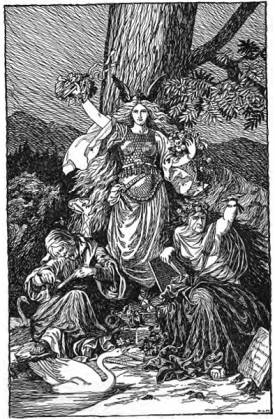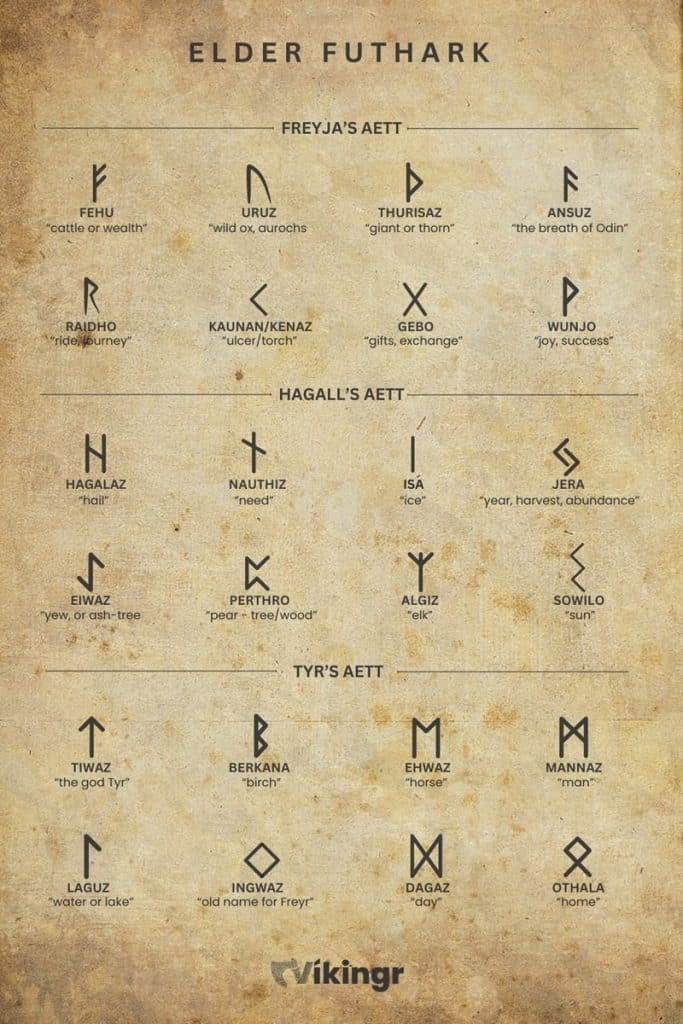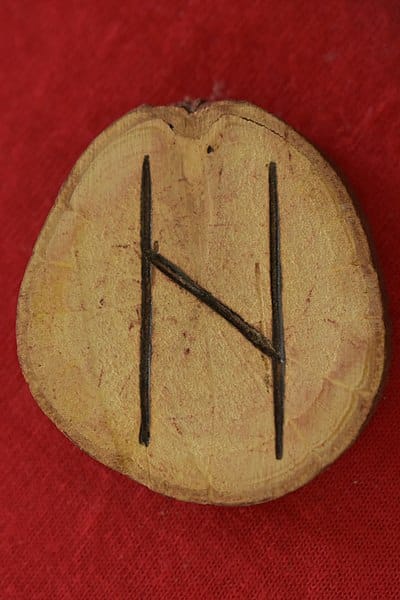Welcome back, fellow seekers of ancient wisdom! Today, we’re journeying once more into the world of the enigmatic runic alphabet, the Elder Futhark. Our focus? The ninth rune in this ancient alphabet, Hagalaz, a symbol of disruption and transformation.
Hagalaz Background and Description
Let’s start at the beginning, with the Elder Futhark, the oldest form of the runic alphabets. Hagalaz is the first rune in the second aett, also known as Hagall’s aett from ist association with Heimdall, who is also called Hagal. As the ninth rune in the Elder Futhark, it follows Wunjo and precedes Nauthiz. The name comes from Old Norse “Hagall” translating roughly to “hail” or “hailstone.”
Across Europe, from Scandinavia to the British Isles and far south on the European continent, people used the Elder Futhark. Inscriptions from the Elder Futhark appear on everything from monumental runestones to simple everyday objects.
The etymology of “Hagalaz” captivates with its intrigue. It roots in the Proto-Germanic “*hagalaz,” associating with hail, a force of nature that can be both destructive and nourishing. This association offers a glimpse into the mindset of the ancient Germanic peoples, revealing their recognition of life’s many dual aspects.
Graphical Representation

Hagalaz, a simple yet powerful rune, visually comprises two vertical lines intersected by one or two nearly horizontal lines in the middle, forming an “H” shape.
Historically, we’ve discovered variations of Hagalaz’s design. Some inscriptions depict the rune with more curved lines or with one or two horizontal lines. Yet, the traditional form with one line continues to be the most recognized and used.
Phonetic Value
In the Proto-Germanic language, Hagalaz represented the sound “h,” as in “hail.” As Germanic languages evolved, so did the pronunciation of this rune. In Old Norse, for example, it was pronounced as a guttural “h.”
Symbolic Meaning of the Hagalaz Rune
Now, let’s delve into the symbolic heart of Hagalaz. This rune is traditionally associated with disruption and transformation. It represents the hailstorm that destroys the crops, but also nourishes the soil, preparing it for the next cycle of growth.
The rune is also linked to the Norns, the Norse wise women of fate. In this context, Hagalaz can symbolize the inevitable changes that life brings, and the need to adapt and grow with these changes.

The weavers of fate, the Norns, are central figures in Norse mythology, embodying the cyclical nature of life and the inevitability of change. Also captured in the more modern concept of the Web of Wyrd. Hagalaz, with its associations with disruption and transformation, reflects these themes, offering a glimpse into the values and beliefs of the ancient Germanic peoples.
The Aett and its Symbolism
Hagalaz belongs to the second aett of the Elder Futhark, a group of eight runes associated with the god Heimdall and the goddess Skadi. This aett, or family of runes, carries themes of resistance, survival, and the cyclical nature of life.
Heimdal, the Guardian of the Gods, is the god associated with this aett. Heimdall, the vigilant guardian, embody the themes of resistance and survival that permeate this aett. Hagalaz, with its symbolism of disruption and transformation, fits perfectly within this narrative, reminding us that change, though often challenging, is a necessary part of life’s cycle.

Elder Futhark Quiz
Do you want to test your knowledge of Elder Futhark runes? Then this quiz is perfect for you!
Don’t forget to play our other games as well!
Hagalaz Used in Divination and Magic

I must confess, while I don’t personally believe in divination or magic, I find the historical and cultural aspects of this intriguing. Rune casting is also having a big renaissance and I might have to reconsider my beliefs. In runic divination, Hagalaz is often seen as a sign of disruption, a signal that a storm may be on the horizon. But remember, storms, while destructive, also bring rain, which nourishes the earth and allows new growth to occur.
Historically, it’s possible that Hagalaz was used in magical practices. Imagine a Viking warrior etching this rune onto his weapon, hoping to disrupt his enemies in battle. Or perhaps a farmer inscribing it onto a stone, hoping for the hail to pass over his fields.
In modern times, some practitioners of runic magic use Hagalaz in rituals or spells aimed at bringing about change or transformation. While I don’t personally practice this, I respect the cultural significance and personal meaning it holds for many.
Frequently Asked Questions
Hagalaz represents disruption and transformation. It’s a symbol of the inevitable changes that life brings.
Hagalaz is pronounced “hah-gah-lahz,” with the “h” sound as in “hat.”
In divination, Hagalaz often signifies a period of disruption or transformation coming into one’s life.
It belongs to the second aett of the Elder Futhark, associated with Heimdall.
Featured Image Credit: BK, Public domain, via Wikimedia Commons

This is cool. On my own personal journey right now. My parents named me Erik when I was adopted. I see this as an opportunity to to plot my own course through the cosmos. I enjoy chasing the paranormal but “suffer” from a scientific bent. I am currently trying to learn the Nordic/ Viking alphabet in an attempt to tie it into Wiccan beliefs. As a lifelong drummer, I am also trying to learn shamanic beats to aid in meditation. It is my hope that I can eventually become a shamanic bard that will be able to help others reach the place spiritually that I hope to attain.
Hey Erik, thanks so mych for sharing! Love your honesty and wish you all the best on your journey. Maybe check out Wardruna if you haven’t listened to them yet.